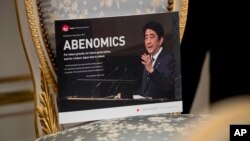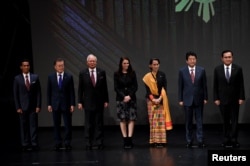Japan is stepping up aid and investment in Southeast Asia to help its multinationals do business across the continent while vying with political rival China for long-term influence over smaller neighboring countries.
The wealthy Asian nation is helping build a train line near Manila, a seaport in Cambodia and new support for the Trans Pacific Partnership trade deal following the U.S. withdrawal in January -- to name just three recent offers for Southeast Asia.
This week Prime Minister Shinzo Abe attended the Association of Southeast Asian Nations (ASEAN) summits in Manila to meet leaders of 10 association member states. They agreed to enhance a 9-year-old ASEAN-Japan trade agreement.
The super-modern Asian nation hopes to secure a hassle-free, land-and-sea transit route as far as Africa, Abe's spokesman Norio Murayama said. Southeast Asia is along the route. Japan, Asia's second largest economy after China, looks to the smaller countries for land, cheap labor and resources, as well.
“For Japan, the country surrounded by the sea, a maritime order is extremely important,” Murayama told a news conference at the events in Manila.
“But maritime order, it’s faced with a number of threats, including piracy, terrorism, proliferation of weapons of mass destruction and natural disaster, so we need to promote the idea to remove this kind of threat and create this area for international and public space that bring about stability and prosperity equal to all the countries,” he said.
Shipping lanes, factory bases
Japanese investment in Southeast Asia’s six biggest countries averaged $20 billion per year from 2011 to 2016, more than double the average annual flows from 2006 to 2010, DBS Bank estimates.
About 35 percent of Japan's global aid was going to Southeast Asia as of 2011.
Tokyo particularly wants open shipping lanes, said Jeffrey Kingston, author and history instructor at Temple University Japan. It may worry that Beijing will try for total control over navigation in the South China Sea, which it claims over the objections of four Southeast Asian counties.
“Southeast Asia is vitally important to Japan in terms of resources, in terms of geopolitical position, the major trade routes connecting Japan to the Middle East and Africa,” Kingston said. “A lot of Japanese investment, a lot of factories’ offshore operations [are] located there.”
At international events, government officials hold talks to figure out who needs help where in Southeast Asia. They offered last month to help the Philippines rebuild a city torn by fighting with Muslim rebels, to name one example.
Japan ultimately hopes to help set rules for Asia, Kingston said, as ASEAN does for its bloc covering 630 million people. “Japan wants to be at the heart of shaping the rules for the emerging regional order,” he said.
Japanese direct aid worldwide increased 12.7 percent last year over 2015 to $10.37 billion. Japan has also expanded the mandate for that aid, including “human security” and “sustainable development” based on individual country needs, according to its Foreign Ministry’s website.
Disputes with China
China and Japan still face unresolved issues from World War II as well as dispute over islets in the East China Sea. China has regularly sent ships and planes near those islands since 2013 to assert its claim.
The East China Sea issue, plus wariness about Beijing’s grip on the South China Sea -- a separate dispute not involving Japan -- have prompted Tokyo to factor in freedom of navigation, rule of law and security when making aid calculations, analysts believe.
Japanese assistance usually comes piecemeal and through government as well as private sources, different from the sudden, massive offers that China has been able to offer over the past half-decade.
China’s showpiece is the $900 billion, four-year-old “One Belt, One Road” infrastructure building campaign across Eurasia.
Southeast Asia is receptive
ASEAN noticed the support of Japan as well as South Korea at the Nov. 13 and 14 summits in Manila, said Emmanuel Leyco, undersecretary of the Philippine Department of Social Welfare and Development.
“I think to a large extent both countries, although they’re not part of the ASEAN, they have been very, very supportive of the initiatives of ASEAN,” Leyco said on the sidelines of the summits Monday. “They support our activities, not necessarily direct funding, but they have activities that are in line with what the ASEAN is doing.”
The Japanese role in Southeast Asia will be more obvious as U.S. President Donald Trump lacks comparable outreach, said Stephen Nagy, senior associate political science professor at International Christian University in Tokyo.
Trump told ASEAN leaders in Manila he wants more “fair trade” in the region, short of a program to supply a range of aid or investment.
“Japan plays an important role here as a supporting pillar of an evolving strategic partnership in the region to balance China's expanding economic, diplomatic and security footprint in the region,” Nagy said.








